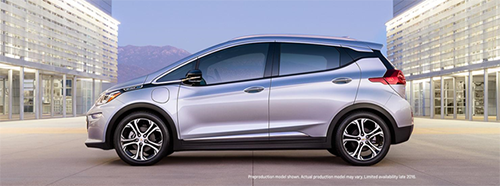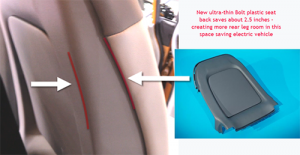Lightweighting in the 2017 Green Car of the Year

Electric cars can play an important role making our world more sustainable and energy efficient, and helping the automotive industry meet growing global emission regulations. However, some consumers still view EVs with practical skepticism for their day-to-day lives, due to the often limited driving ranges offered …until now.
Enter the Chevy Bolt, 2017’s Green Car of the Year – Range: 238 miles
Not to be confused with the Chevrolet Volt, which can go about 50 miles on a single charge, the Chevy Bolt is an all-electric vehicle offering an EPA-estimated 238 miles (!) of range per full charge — five times the amount needed for the average daily commute of 40 miles. What’s more, it’s reported that the Bolt can go from zero to 60 in under 7 seconds, now that is some good ole electric torque, and delivers highway speeds up to 91 mph.
To help maximize the Bolt’s range, this revolutionary EV is made from lightweight materials such as carbon fiber reinforced plastic (CFRP). With lighter weight CFRP, electric cars like the Chevy Bolt can drive for longer distances and accelerate more quickly while maintaining many important driver safety features (remember, although carbon fiber is extremely lightweight, it is also very strong in the crumple zone). This makes energy-efficient electric cars more appealing to average consumers, and more realistic for their day-to-day lives.
If the Chevy Bolt isn’t proof enough of what lightweighting plastic materials can do, a recent Trucost study showed that using plastics in 2015 vehicles in America alone resulted in:
- $2.4 billion in environmental costs savings;
- $162 per vehicle in environmental cost savings;
- 89 million gallons of gasoline and diesel saved over the lifetime of these vehicles.
According to Ron Cogan, editor and publisher of Green Car Journal, the Chevy Bolt is similar to the invention of the starter engine — it’s going to change everything!
Today, about 50% of most vehicle material volume is made with plastics. But, that volume represents only 10% of a car’s weight. For every 10% reduction in a vehicle’s overall weight, fuel economy can be increased by 6%-8%. As the use of CFRP continues to become more mainstream for the automotive industry, we can expect to see beneficial changes in vehicle affordability, fuel efficiency and range, EV or not!
Thanks to lightweight materials like plastic composites and carbon fiber, we can get more electric vehicles on the road. And more EVs on the road means a cleaner, greener world, never mind the fuel savings!





